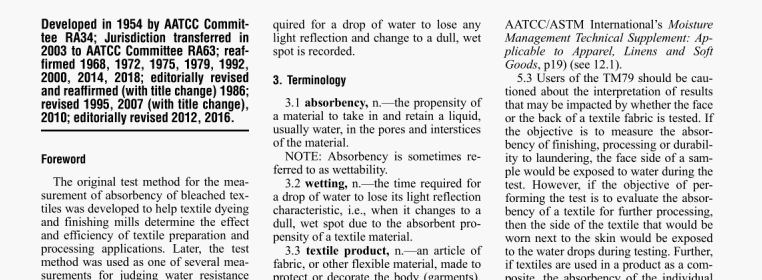Absorbency of Textiles

AATCC 79-2018 free download.Absorbency of Textiles.
Taketwo200±5×200±5mm specimens from each sample on which a total of five water drop sites can be tested. If suficient fabric is available,five specimens from different locations of a sample (ie, different length x width locations; side-middle side locations on a sample cut; or front-back-sleeve garment panels) can be prepared for each water drop test site. Otherwise, five water drop tests may be perlbrmed on one specimen ifthc test sites arc at Icast 25 ± 2.5mm (1± 0.12 in.) away from the hoop edge and no closer together than 25 * 2.5 mm (1± 0.12 in.) from the water drop test site’s outside edge. For performing the 5-drop testing on garments or full cuts of a sample. it may not be necessary to cut specimens from the actual sample but insert dilicrent areas in the embroidery hoop.
If pertbrrning tests on yarns, skeins should he prepared in such a way that there are no gaps between individual yam wraps when inserted into the embroidery hoop.
Specimens should be brought to moisture equilibrium in a standard atmosphere according to ASTM D1776. Standard Practice for Conditioning and Testing Testiles) (see 12.3) having a relative humidity of 65 ± 50/0 at 21 ± 2°C (70 ± 4’I-’). If the absorbency of a fabric from a wet processing stage is required. such as after bleaching, specimens for testing should be air dried before conditioning prior to testing (see 12.4).
Perform all tests in the standard atmosphere for testing.
Option A — Burette,
Select a location in the conditioned laboratory area that has overheat! lighting to facilitate the judgment of the test end point: i.e., wetting (see 3.2).
Determine the burette’s stopcock position that will deliver the specified number of water drops (see 6.2).
Mount a specimen in an embroidery hoop so that the side of the specimen to be tested is up and the surface specimen is taut and free of wrinkles but without stretching or distorting the structure of the fabric.
Place the embroidery hoop with the specimen surface 10 ± 1.0 tutu (0.394 ± 0.04 in.) below the tip of the burette and allow one drop of distilled or deionized water to fall on the cloth. Suirt the stopwatch or timer immediately. Observe the water drop without moving the beaker with the specimen from under the burette to avoid disturbance of the water drop and its interface with the specimen surface.
Stop the timer or stopwatch when the drop of water loses its reflectivity (see 3.2). If the watcr drop does not immediately disappear. observe the water drop from other positions until it finally vanishes. The end point will be the time, less than 60 s, it takes for the water drop to no longer reflect light and appear only as a dull wet spot.
8.2.6 Record the elapsed time to the nearest second. If the water drop disappears immediately, record as zcro.” If the welting time exceeds 60 s, record the time as ‘60
8.2.7 Repeat steps 8.2.4-8.2.6 for the additional four test locations.
8.3 Option B — Medicine Dropper.
8.3.1 Follow steps 8.2.3-8.2.6 except using the specified medicine dropper that is held at an approximate 10 mm height from the test specimen surface is used. A 10 1.0 mm height sighting device can be made to help assure consistent height placement of the medicine dropper. Do not move the specimen in the embroidery hoop until the water drop no longer reflects light and the site appears only as a dull wet spot. Record the time it takes for a water drop to disappear as stated in 8.2.6. Repeat the steps for all specimens.
Calculate the average and the standard deviation of the five recorded times and report to the nearest second. In the case where the five tests include immediate absorption times (zeroes’), the average should be calculated using all times including tern(s). In the case where some of the five tests include absorption times greater than 64) s (60 +). use all of the wetting times to calculate the average and report with a plus sign (+) and note the number of tests that exceeded 64) s.AATCC 79 pdf download.Absorbency of Textiles